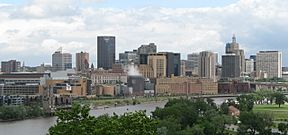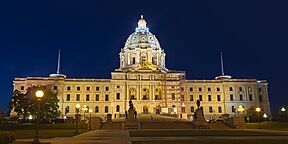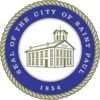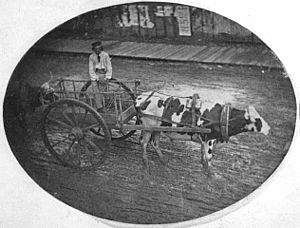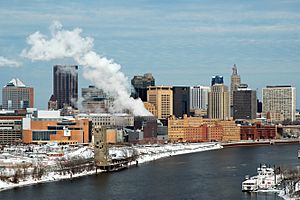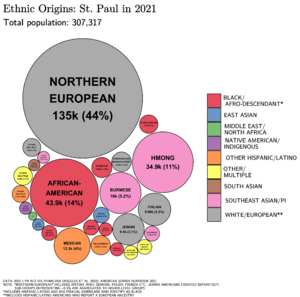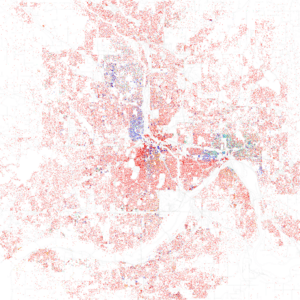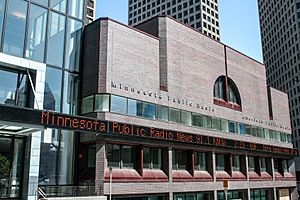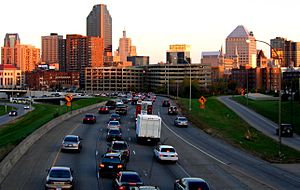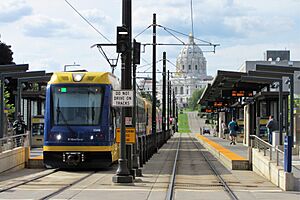Saint Paul, Minnesota facts for kids
Quick facts for kids
Saint Paul
|
|||
|---|---|---|---|
|
Downtown Saint Paul with Harriet Island in the foreground
|
|||
|
|||
| Nicknames:
"the Capital City", "the Saintly City", "Twin Cities" (with Minneapolis), "Pig's Eye", "STP", "Last City of the East"
|
|||
| Motto(s):
The most livable city in America*
|
|||
| Country | United States | ||
| State | Minnesota | ||
| County | Ramsey | ||
| Incorporated | March 4, 1854 | ||
| Named for | St. Paul the Apostle | ||
| Government | |||
| • Type | Mayor–council | ||
| Area | |||
| • City | 56.10 sq mi (145.31 km2) | ||
| • Land | 51.97 sq mi (134.61 km2) | ||
| • Water | 4.13 sq mi (10.70 km2) | ||
| Elevation | 824 ft (251 m) | ||
| Population
(2020)
|
|||
| • City | 311,527 | ||
| • Estimate
(2022)
|
303,176 | ||
| • Rank | US: 67th MN: 2nd | ||
| • Density | 5,994.02/sq mi (2,314.32/km2) | ||
| • Metro | 3,693,729 (US: 16th) | ||
| • Demonym | Saint Paulite | ||
| Time zone | UTC-6 (Central (CST)) | ||
| • Summer (DST) | UTC-5 (CDT) | ||
| ZIP Codes |
55101–55131, 55133, 55144-55146, 55150, 55155, 55164, 55170
|
||
| Area code(s) | 651 | ||
| FIPS code | 27-58000 | ||
| GNIS ID | 2396511 | ||
| Current as of October 12, 2023 | |||
Saint Paul (often called St. Paul) is the capital city of Minnesota, a state in the United States. It is also the main city of Ramsey County. Saint Paul sits on high cliffs overlooking a bend in the Mississippi River. It is a major business center and the home of Minnesota's government. The Minnesota State Capitol building and other state offices are located near the city's downtown area.
Saint Paul is one of Minnesota's oldest cities. It has many historic areas and famous places. These include the Summit Avenue Neighborhood, the James J. Hill House, and the Cathedral of Saint Paul. Just like its neighbor, Minneapolis, Saint Paul has cold, snowy winters and warm, humid summers.
In 2022, about 303,176 people lived in Saint Paul. This makes it the 67th largest city in the United States and the second largest in Minnesota. Most of the city is east of the Mississippi River, where it meets the Minnesota River. Minneapolis is mostly west of the Mississippi. Together, these two cities are known as the "Twin Cities." They form the main part of the Minneapolis–Saint Paul metropolitan area, which is the third largest in the Midwest.
The Minnesota Territory officially made Saint Paul its capital in November 1849. This happened near where the Dakota Sioux people lived. The city was named after a small church built by Lucien Galtier. Before it became a city in 1854, it was just a town. The Dakota people called this area "Imnizaska," meaning "white rock," because of the cliffs along the river. Saint Paul has three major sports venues: Xcel Energy Center, home to the Minnesota Wild and Minnesota Frost; CHS Field, home to the St. Paul Saints; and Allianz Field, home to Minnesota United.
Saint Paul has a mayor–council government. The current mayor is Melvin Carter III. He was first elected in 2018.
Contents
- Saint Paul's Past: A Look at History
- Saint Paul's Location and Natural Beauty
- People and Cultures of Saint Paul
- Saint Paul's Economy and Jobs
- Saint Paul's Culture and Fun
- Sports and Recreation in Saint Paul
- Education and Learning in Saint Paul
- Media and News in Saint Paul
- Getting Around Saint Paul
- Sister Cities Around the World
- Famous People from Saint Paul
- See also
Saint Paul's Past: A Look at History
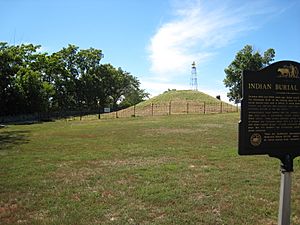
Ancient burial mounds in Indian Mounds Park show that people lived here about 2,000 years ago. These were the Hopewell Native Americans. From the early 1600s to 1837, the Mdewakanton Dakota people lived near these mounds. They considered this area, called Bdóte, to be where their people were created. The Dakota called the area Imniza-Ska ("white cliffs") because of the white sandstone cliffs along the river. These cliffs had caves that were useful to the Dakota.
In 1805, U.S. Army Lieutenant Zebulon Pike made a deal with the Dakota people. He got about 100,000 acres of land to build a fort. This fort, Fort Snelling, was built in 1819 where the Mississippi River and Minnesota River meet. In 1837, a treaty gave all tribal lands east of the Mississippi to the U.S. government. Chief Little Crow III moved his village, Kaposia, across the river.
Fur traders, explorers, and settlers came to the area for the fort's safety. Many were French-Canadians. A community grew outside the fort's land, and people called it Pig's Eye or Pig's Eye Landing. This name came from a popular tavern owned by "Pig's Eye" Parrant. In 1840, Pierre Bottineau became an important resident.
In 1841, a Catholic missionary named Lucien Galtier built a small church. He named it for St. Paul. Galtier told the settlers to use this name for their community instead of "Pig's Eye." In 1847, Harriet Bishop opened the city's first school. The Minnesota Territory was created in 1849, with Saint Paul as its capital. In 1857, some lawmakers tried to move the capital, but a legislator named Joe Rolette stopped it.
By 1858, Saint Paul was a busy port for steamboats. It became a gateway for settlers moving into the Minnesota frontier. The city was sometimes called "The Last City of the East." Fort Snelling was very important to Saint Paul. Industrialist James J. Hill built his railroad business in Saint Paul. The Great Northern Railway and the Northern Pacific Railway were based here.
In the 1960s, parts of Saint Paul were changed to build the interstate highway system. The Rondo neighborhood, a community of African American families, was removed to build Interstate 94. This event helped people understand issues of fairness in housing. Today, the annual Rondo Days celebration remembers this community.
Downtown Saint Paul saw many tall buildings built starting in the 1970s. The city's tallest building is Wells Fargo Place. In the 1990s and 2000s, many new immigrant groups came to the city. By 2004, almost 10% of the city's people were Hmong immigrants from Southeast Asia. Saint Paul is home to the Hmong Archives.
Saint Paul's Location and Natural Beauty
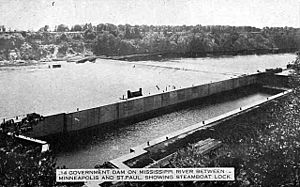
Saint Paul's history and growth are closely linked to its rivers. The city's main feature is where the Mississippi River and Minnesota River meet. This area was shaped by the last ice age, which also created the steep river bluffs and cliffs. The city is located in east-central Minnesota.
The Mississippi River forms part of the city's border on the west, southwest, and southeast. Minneapolis, Minnesota's largest city, is to the west. Other nearby cities include Falcon Heights, Lauderdale, Roseville, and Maplewood to the north and east. West Saint Paul and South Saint Paul are to the south.
The city's biggest lakes are Pig's Eye Lake (part of the Mississippi), Lake Phalen, and Lake Como. Saint Paul covers about 56.18 square miles (145.51 square kilometers). About 51.98 square miles (134.63 square kilometers) is land, and 4.20 square miles (10.88 square kilometers) is water.
The Parks and Recreation department manages 160 parks and 41 recreation centers. In 2018, Saint Paul's park system was ranked second best in the U.S. for access and quality, just after Minneapolis.
Saint Paul's Neighborhoods
Saint Paul is divided into 17 Planning Districts. These were created in 1979 to help neighborhoods take part in city decisions. These districts often match up with older, traditional neighborhoods. They help guide development and organize residents.
The city's 17 Planning Districts are:
- Southeast
- Greater East Side
- West Side
- Dayton's Bluff
- Payne-Phalen
- North End
- Thomas Dale (Frogtown)
- Summit-University
- West Seventh
- Como Park
- Hamline-Midway
- Saint Anthony Park
- Union Park
- Macalester-Groveland
- Highland Park
- Summit Hill
- Downtown
Saint Paul's Climate and Weather
Saint Paul has a humid continental climate. This means it has very cold and snowy winters. Summers are warm to hot and humid. The city experiences all kinds of weather, including snow, ice, rain, thunderstorms, and fog.
Because it is so far north and doesn't have large bodies of water nearby, Saint Paul often gets very cold air from the Arctic. This happens especially in December, January, and February. The average yearly temperature is 46.5°F (8.1°C). This makes the Minneapolis−Saint Paul area the coldest major metropolitan area in the continental U.S.
Climate change is expected to affect Saint Paul. The city may see more extreme heat waves. Also, more rain in spring and summer could cause flooding.
| Climate data for St. Paul Downtown Airport, Minnesota (1991–2020 normals, extremes 1872–present) | |||||||||||||
|---|---|---|---|---|---|---|---|---|---|---|---|---|---|
| Month | Jan | Feb | Mar | Apr | May | Jun | Jul | Aug | Sep | Oct | Nov | Dec | Year |
| Record high °F (°C) | 58 (14) |
64 (18) |
83 (28) |
93 (34) |
99 (37) |
101 (38) |
104 (40) |
104 (40) |
101 (38) |
90 (32) |
78 (26) |
63 (17) |
104 (40) |
| Mean daily maximum °F (°C) | 23.9 (−4.5) |
28.7 (−1.8) |
41.7 (5.4) |
56.8 (13.8) |
68.9 (20.5) |
78.5 (25.8) |
82.6 (28.1) |
80.4 (26.9) |
72.4 (22.4) |
58.0 (14.4) |
42.1 (5.6) |
28.6 (−1.9) |
55.2 (12.9) |
| Daily mean °F (°C) | 16.3 (−8.7) |
20.8 (−6.2) |
33.1 (0.6) |
47.0 (8.3) |
58.9 (14.9) |
68.8 (20.4) |
73.3 (22.9) |
71.1 (21.7) |
62.9 (17.2) |
49.0 (9.4) |
34.6 (1.4) |
21.7 (−5.7) |
46.5 (8.1) |
| Mean daily minimum °F (°C) | 8.6 (−13.0) |
12.9 (−10.6) |
24.6 (−4.1) |
37.2 (2.9) |
48.9 (9.4) |
59.2 (15.1) |
64.0 (17.8) |
61.7 (16.5) |
53.4 (11.9) |
40.0 (4.4) |
27.1 (−2.7) |
14.8 (−9.6) |
37.7 (3.2) |
| Record low °F (°C) | −41 (−41) |
−33 (−36) |
−26 (−32) |
6 (−14) |
23 (−5) |
34 (1) |
45 (7) |
39 (4) |
28 (−2) |
8 (−13) |
−25 (−32) |
−39 (−39) |
−41 (−41) |
| Average precipitation inches (mm) | 0.48 (12) |
0.52 (13) |
1.43 (36) |
2.58 (66) |
3.97 (101) |
4.63 (118) |
3.97 (101) |
4.10 (104) |
3.08 (78) |
2.47 (63) |
1.32 (34) |
0.65 (17) |
29.20 (742) |
| Average precipitation days (≥ 0.01 in) | 4.0 | 4.3 | 7.1 | 10.6 | 12.7 | 13.0 | 9.9 | 10.0 | 9.6 | 9.2 | 6.2 | 4.9 | 101.5 |
| Source 1: NOAA | |||||||||||||
| Source 2: The Weather Channel | |||||||||||||
People and Cultures of Saint Paul
| Historical population | |||
|---|---|---|---|
| Census | Pop. | %± | |
| 1850 | 1,112 | — | |
| 1860 | 10,401 | 835.3% | |
| 1870 | 20,030 | 92.6% | |
| 1880 | 41,473 | 107.1% | |
| 1890 | 133,156 | 221.1% | |
| 1900 | 163,065 | 22.5% | |
| 1910 | 214,744 | 31.7% | |
| 1920 | 234,698 | 9.3% | |
| 1930 | 271,606 | 15.7% | |
| 1940 | 287,736 | 5.9% | |
| 1950 | 311,349 | 8.2% | |
| 1960 | 313,411 | 0.7% | |
| 1970 | 309,980 | −1.1% | |
| 1980 | 270,230 | −12.8% | |
| 1990 | 272,235 | 0.7% | |
| 2000 | 287,151 | 5.5% | |
| 2010 | 285,068 | −0.7% | |
| 2020 | 311,527 | 9.3% | |
| 2023 (est.) | 303,820 | 6.6% | |
| U.S. Decennial Census 2020 Census |
|||
| Demographic profile | 2020 | 2010 | 2000 | 1990 | 1970 |
|---|---|---|---|---|---|
| White (non-Hispanic) | 48.8% | 55.9% | 64.0% | 80.4% | 93.6% |
| Asian (non-Hispanic) | 19.2% | 14.9% | 12.4% | 7.1% | 0.2% |
| Black or African American (non-Hispanic) | 16.5% | 15.3% | 11.7% | 7.4% | 3.5% |
| Hispanic or Latino | 9.7% | 9.6% | 7.9% | 4.2% | 2.1% |
Population in 2020
In 2020, Saint Paul had a population of 311,527 people. The city had about 5,994 people per square mile (2,314 per square kilometer). There were 127,392 homes.
The city's population was made up of different groups:
- 50.5% White (many with German roots)
- 19.2% Asian (including Hmong, Burmese, Vietnamese, Chinese, and Indian people)
- 16.8% Black or African American (including Somali and Ethiopian people)
- 1.0% Native American
- 4.8% from other backgrounds
- 7.6% from two or more backgrounds
People of Hispanic or Latino heritage made up 9.7% of the population. This includes many Mexican and Salvadoran people.
In 2020, the average household income was $59,717. The average family income was $74,852. About 17.9% of the population lived below the poverty line. This included 27.0% of those under 18. Most adults (87.6%) had finished high school or higher. Also, 41.3% had a bachelor's degree or more.
Saint Paul's Diverse Ethnic History
The first known people in the Saint Paul area were the Hopewell tradition about 400 AD. They buried their dead in mounds, which you can still see at Indian Mounds Park. Later, in the 1600s, the Mdewakanton Dakota people lived here.
By 1800, French-Canadian explorers and fur traders arrived. Early settlers also came from New England, England, Ireland, and Scotland. The first large group of immigrants were the Irish. They settled in an area called Connemara Patch. The Irish became very involved in local politics and city government.
In the 1850s, many Swedish immigrants passed through Saint Paul. Some settled in Swede Hollow. Over time, this area also became home to Polish, Italian, and Mexican families.
By the 1980s, the Thomas-Dale area, also known as Frogtown, welcomed many Vietnamese and other Southeast Asian people. A program helped Hmong families settle here. By 2000, Saint Paul had the largest Hmong population in the U.S.
Today, Hmong Americans make up about 11% of Saint Paul's population. The Twin Cities area is a major center for Hmong culture in America. You can find many Hmong businesses and events in neighborhoods like Frogtown and Payne-Phalen.
Other large Southeast Asian groups also live in Saint Paul. These include Burmese Americans from the Karen and Karenni groups. Many came as refugees in the 2000s and 2010s. Minnesota has the largest population of Karen Americans, with many living in Saint Paul.
Mexican immigrants have settled in Saint Paul since the 1930s. The largest group of Mexican Americans lives on Saint Paul's West Side. Saint Paul also has many Central Americans, especially Salvadorans.
Since the 1990s, Saint Paul has welcomed many Somalis and Ethiopians. They came as refugees from conflicts in their home countries. These communities are largest in the Summit-University and Frogtown neighborhoods.
African Americans have a long history in Saint Paul. Today, they are one of the largest groups in the city, making up about 14% of the population. They live mostly in the central and eastern neighborhoods.
Most people in Saint Paul who follow a religion are Christian. There are also many Jewish synagogues, Hindus, Muslims, and Buddhists.
Saint Paul's Economy and Jobs
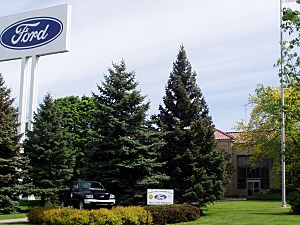
The Minneapolis–Saint Paul–Bloomington area has many jobs. In July 2008, about 1.57 million people worked in the private sector. Most of these jobs were in service industries.
Some big companies have their main offices in Saint Paul. These include Ecolab, which makes cleaning products, and Securian Financial Group Inc..
The 3M Company moved to Saint Paul in 1910. Its old headquarters building still stands. While 3M's main offices moved in 1964, manufacturing continued in Saint Paul for many years.
The city was also home to the Ford Motor Company's Twin Cities Assembly Plant. This factory opened in 1924 and closed in 2011. The land where it stood is now being redeveloped into a new area called Highland Bridge. This new area will have 3,800 homes.
Saint Paul uses a special way to fund city projects called tax increment financing (TIF). This helps pay for things like the St. Paul Saints stadium and affordable housing along the Metro Green Line.
Housing in Saint Paul
In November 2021, Saint Paul became the only city in the Midwest to control how much landlords can raise rent. Voters approved a rent control rule. This rule limited yearly rent increases to three percent. In September 2022, the city council changed the rule. It now allows higher increases when a tenant moves out. Also, new buildings (built within 20 years) are not limited by the rent cap.
Saint Paul's Culture and Fun
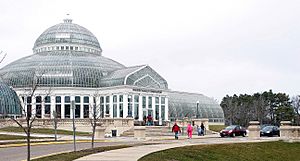
Every January, Saint Paul hosts the Saint Paul Winter Carnival. This tradition started in 1886. It includes ice sculpting, snow sculpting, a treasure hunt, food, and activities. Sometimes, they even build an ice palace!
The Como Zoo and Conservatory and its Japanese Garden are popular places to visit all year. The historic Landmark Center in downtown Saint Paul is home to many cultural and arts groups. The city has many parks and recreation spots. These include Indian Mounds Park, Harriet Island Regional Park, and Lake Como. The Irish Fair of Minnesota is held every year at Harriet Island Pavilion. The largest Hmong American sports festival, the Freedom Festival, happens in July near Como Park.
The city is also connected to the Minnesota State Fair. This big fair takes place in nearby Falcon Heights. It started even before Minnesota became a state.
Fort Snelling is often thought of as being in Saint Paul. However, it is its own special area. The eastern part of Fort Snelling, including the airport, has a Saint Paul mailing address.
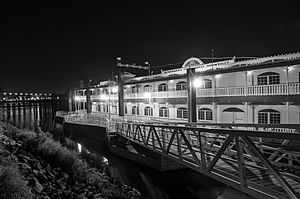
Saint Paul is the birthplace of cartoonist Charles M. Schulz, who created Peanuts. The city once had giant, decorated sculptures of his characters. Other famous people from Saint Paul include writer F. Scott Fitzgerald and playwright August Wilson.
The Ordway Center for the Performing Arts hosts plays and the Minnesota Opera. RiverCentre is the city's convention center. Saint Paul has a lively music scene. The Artists' Quarter is a famous jazz club. The Turf Club has been a music landmark since the 1940s. The Saint Paul Chamber Orchestra is the only full-time professional chamber orchestra in the nation. The Minnesota Centennial Showboat has been on the Mississippi River since 1958.
Saint Paul has many museums. These include the Minnesota Children's Museum, the Minnesota Museum of American Art, the Minnesota History Center, and the Science Museum of Minnesota.
Sports and Recreation in Saint Paul
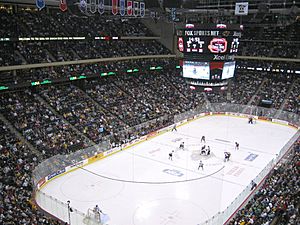
Saint Paul's Parks and Recreation department manages over 1,500 organized sports teams.
Saint Paul is home to several professional sports teams. The Minnesota Wild hockey team plays its home games at the Xcel Energy Center downtown. The Wild brought the NHL back to Minnesota in 2000. In 2007, Sports Illustrated called Saint Paul the new "Hockeytown U.S.A."
The Xcel Energy Center is a large venue for sports and concerts. It hosts the Minnesota high school boys' hockey tournament. In 2004, ESPN named it the best overall sports venue in the U.S.
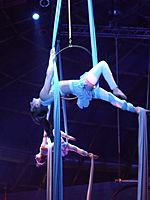
The St. Paul Saints are the city's Minor League Baseball team. They play in the International League and are connected to the Minnesota Twins. The Saints were first founded in 1884. They were brought back in 1993. Their home games are played at CHS Field in downtown's Lowertown. Many famous baseball players from Saint Paul, like Dave Winfield, Paul Molitor, Jack Morris, and Joe Mauer, played for the Minnesota Twins.
Saint Paul's first curling club started in 1888. The current club, the St. Paul Curling Club, is the largest in the United States. Minnesota Roller Derby is a roller derby league based at the Roy Wilkins Auditorium. The Minnesota Boat Club is the state's oldest athletic group. Saint Paul is also home to Circus Juventas, the largest circus arts school in North America.
In 2015, Major League Soccer announced that Minnesota United FC would join the league. Their stadium, Allianz Field, opened in April 2019 and seats 19,400 people. It is located in Saint Paul's Midway neighborhood.
The Minnesota Whitecaps women's hockey team joined the Premier Hockey Federation in 2018. They won the Isobel Cup in their first season. In 2023, a new professional women's league, the Professional Women's Hockey League (PWHL), started. The new team, Minnesota Frost, plays its home games at the Xcel Energy Center.
Other major sports teams like the Timberwolves (basketball), Twins (baseball), Vikings (football), and Lynx (women's basketball) play in Minneapolis.
| Club | Sport | League | Venue (capacity) | Championships |
|---|---|---|---|---|
| Minnesota Wild | Ice hockey | National Hockey League | Xcel Energy Center (17,954) | — |
| Minnesota Frost | Ice hockey | Professional Women's Hockey League | Xcel Energy Centre | PWHL: 2024 |
| Minnesota United FC | Soccer | Major League Soccer | Allianz Field (19,400) | NASL: 2011 and 2014 |
| Minnesota Wind Chill | Ultimate | Ultimate Frisbee Association | Sea Foam Stadium (3,500) | UFA: 2024 |
| St. Paul Saints | Baseball | International League | CHS Field (7,210) | NL: 1993, 1995, 1996, and 2004
AA: 2019 |
Education and Learning in Saint Paul
Saint Paul has many colleges and universities. It is second in the U.S. for the number of higher education schools per person, after Boston. Well-known colleges include Saint Catherine University, Concordia University, Hamline University, Macalester College, and the University of St. Thomas. Metropolitan State University and Saint Paul College are also in Saint Paul.
The Saint Paul Public Schools district is the largest school district in Minnesota. It serves about 39,000 students. The students come from families who speak 90 different languages. The district runs 82 different schools. This includes elementary, middle, and high schools. It also has alternative schools and a special education school. The district employs over 6,500 teachers and staff.
Saint Paul also has many private and public charter schools. In 1992, Saint Paul was the first U.S. city to open a charter school. The Saint Paul Public Library system has a main library, twelve branch locations, and a bookmobile.
Media and News in Saint Paul
Saint Paul residents can watch 10 broadcast television stations. Five of these stations broadcast from Saint Paul. The city has one main newspaper, the St. Paul Pioneer Press. There are also several local neighborhood papers. Media from Minneapolis, like the Star Tribune, also serve Saint Paul.
Saint Paul is home to two national broadcasting companies. Hubbard Broadcasting has its headquarters on the border between Saint Paul and Minneapolis.
Minnesota Public Radio (MPR) broadcasts on almost 40 stations across the Midwest. It provides local news, classical music, and a wide variety of other music. MPR has over 110,000 members and more than 1 million listeners each week. Its parent company, American Public Media Group, creates and shares programs like Marketplace.
Getting Around Saint Paul
Highways and Roads
|
Interstate Highways |
People in Saint Paul use Interstate 35E (north-south) and Interstate 94 (east-west). Other main highways include U.S. Highway 52 and Minnesota State Highway 5. Saint Paul has some unique roads that follow the city's natural features.
Biking is becoming more popular. There are more paved bike lanes that connect to other routes. Nice Ride Minnesota is a bike-sharing system in both Minneapolis and Saint Paul. Downtown Saint Paul has a five-mile (8 km) enclosed skyway system. The Avenue of the Saints connects Saint Paul with St. Louis, Missouri.
The way Saint Paul's streets are laid out has often caused confusion. This is partly because of the Mississippi River's curves and the city's hills. Outside of downtown, the roads are easier to understand.
Public Transportation
Metro Transit offers bus and light rail service in the Minneapolis–Saint Paul area. The METRO Green Line is an 11-mile (18 km) light rail line. It connects downtown Saint Paul to downtown Minneapolis. It has 14 stations in Saint Paul. The Green Line started service on June 14, 2014. In 2018, it averaged 42,500 rides each weekday. A new rail line, the Riverview Corridor, is being planned to connect downtown Saint Paul to the airport.
The METRO A Line opened in 2016. It was the first fast bus line in the area. It connects to the Blue Line and the Green Line. More METRO lines are planned for Saint Paul.
Train Travel
Amtrak's Empire Builder train stops in Saint Paul twice a day. This train travels between Chicago and Seattle or Portland. It stops at the newly renovated Saint Paul Union Depot. A new Amtrak line, the Borealis, started service on May 21, 2024. It runs between Saint Paul and Chicago.
Saint Paul is home to the Pig's Eye Yard. This is a large freight yard for Canadian Pacific Railway. Other railroads also use this yard.
Airports
Holman Airfield is across the river from Downtown Saint Paul. It is a smaller airport used for local corporate flights and flight training. It also hosts Minnesota's Air National Guard.
Most of Saint Paul's air travel needs are met by the Minneapolis–Saint Paul International Airport (MSP). This airport is located southwest of the city. MSP serves 17 airlines and is a hub for Delta Air Lines and Sun Country Airlines.
Sister Cities Around the World
Saint Paul has several sister cities in other countries:
 Changsha, China
Changsha, China Ciudad Romero, El Salvador
Ciudad Romero, El Salvador Culiacán, Mexico
Culiacán, Mexico Djibouti City, Djibouti
Djibouti City, Djibouti George, South Africa
George, South Africa Manzanillo, Mexico
Manzanillo, Mexico Modena, Italy
Modena, Italy Mogadishu, Somalia
Mogadishu, Somalia Nagasaki, Japan (since 1955 – the oldest sister city in Japan)
Nagasaki, Japan (since 1955 – the oldest sister city in Japan) Neuss, Germany
Neuss, Germany Novosibirsk, Russia
Novosibirsk, Russia Tiberias, Israel
Tiberias, Israel
Famous People from Saint Paul
- Walter Abel (1898–1987), actor
- Loni Anderson (born 1946), actress
- Louie Anderson (1953–2022), comedian
- Wendell Anderson (1933–2016), U.S. senator
- Richard Arlen (1899–1976), actor
- Merrill Ashley (born 1950), ballet dancer
- Roger Awsumb (1928–2002), TV show host
- Azayamankawin (c. 1803–c. 1873), canoe ferry operator
- Harry Blackmun (1908–1999), U.S. Supreme Court justice
- Justin Braun (born 1987), hockey player
- Herb Brooks (1937–2003), hockey coach
- Warren E. Burger (1907–1995), U.S. Supreme Court chief justice
- Charles Burlingame (1949–2001), pilot
- Melva Clemaire (1874–1937), singer
- Laura Coates, attorney and media personality
- Nia Coffey (born 1995), WNBA player
- Kevin Eakin (born 1981), NFL player
- Sarah K. England, physiologist
- Robert J. Ferderer (1934–2009), politician
- F. Scott Fitzgerald (1896–1940), author
- David Graham (born 1953), architect
- Daniel W. Hand (1869–1945), U.S. Army brigadier general
- Josh Hartnett (born 1978), actor
- Andrew Osborne Hayfield (1905–1981), businessman and politician
- Mitch Hedberg (1968–2005), comedian
- James J. Hill (1838–1916), railroad builder
- Paul Holmgren (born 1955), NHL player and team executive
- Nellie A. Hope (1864–1918), violinist and conductor
- JoAnna James (born 1980), singer/songwriter
- Nick Jensen (born 1990), NHL player
- Timothy M. Kaine (born 1958), U.S. senator and governor
- Rachel Keller (born 1992), actress
- Allan Kingdom (born 1993), rap artist
- Norman Kittson (1814–1888), fur trader
- Jim Lange (1932–2014), TV presenter
- Sunisa Lee (born 2003), Olympic gymnast and gold medalist
- Joe Mauer (born 1983), MLB player
- Ryan McDonagh (born 1989), NHL player
- Margaret Bischell McFadden, philanthropist
- K'Andre Miller (born 2000), NHL player
- Kate Millett (1934–2017), scholar and author
- Paul Molitor (born 1956), MLB player
- Jack Morris (born 1955), MLB player
- LeRoy Neiman (1921–2012), artist
- Kyle Okposo (born 1988), NHL player
- Bruce Olson (born 1941), missionary
- Tim Pawlenty (born 1960), governor of Minnesota
- Alfred E. Perlman (1902–1983), railroad president
- Dave Peterson (1931–1997), hockey coach
- Emily Rudd (born 1993), actress
- Charles M. Schulz (1922–2000), cartoonist
- Ervin Harold Schulz (1911–1978), newspaper editor and politician
- Meta Schumann (1887–1937), composer
- Joe Shiely Sr (1885–1972), civic leader
- Chad Smith (born 1961), drummer for Red Hot Chili Peppers
- William Smith (1831–1912), U.S. Army paymaster-general
- Terrell Suggs, NFL player
- W.A. Swanberg (1907–1992), biographer
- Frances Tarbox (1874–1959), composer
- Fred Tschida (born 1949), artist
- Lindsey Vonn (born 1984), Olympic skier and gold medalist
- DeWitt Wallace (1889–1981), magazine publisher
- Dave Winfield (born 1951), MLB player
Medal of Honor recipients:
- Civil War: Private Marshall Sherman
- Indian Wars: Pvt. John Tracy
- Indian Wars: Charles H. Welch
- Spanish-American War: Captain Jesse Dyer
- World War II: Captain Richard Fleming
- Korean War: Lt. Colonel John Page
See also
 In Spanish: Saint Paul (Minnesota) para niños
In Spanish: Saint Paul (Minnesota) para niños


